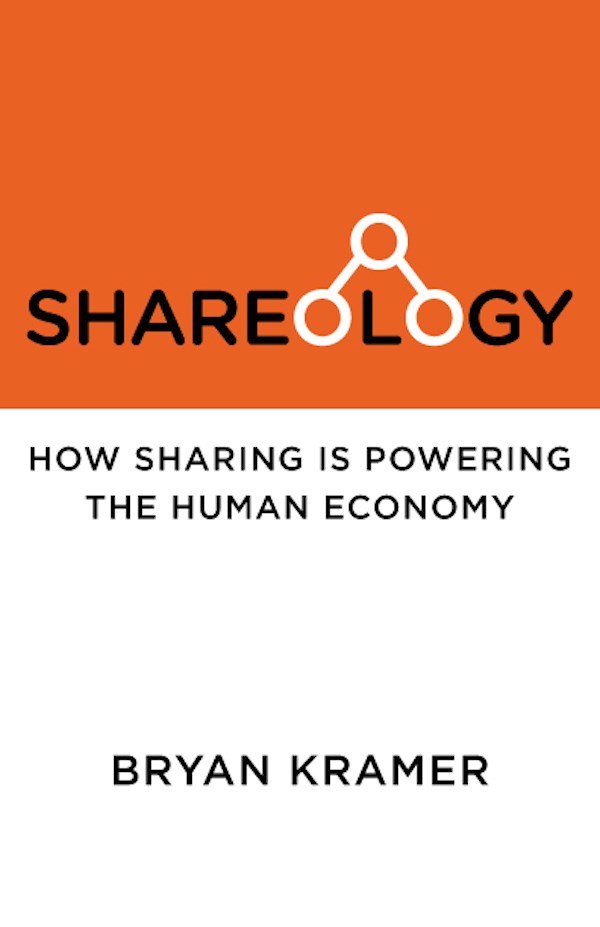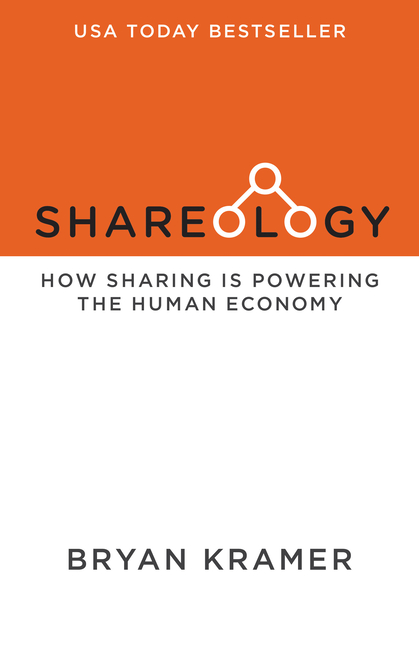Shareology: How Sharing Is Powering the Human Economy
July 30, 2015
Bryan Kramer tells us that, in an increasingly digital world, the economy will become more human and be powered by a fundamental human behavior: sharing.

Shareology: How Sharing Is Powering the Human Economy by Bran Kramer, Morgan James, 220 pages, $16.95, Paperback, July 2015, ISBN 9781630473846
Bryan Kramer’s Sharelogy is a nice blend of futurist vision and traditional values. It is also an example of how to use buzzwords and the business lexicon in an effective and unpretentious way.
Though we’re steeped in business book culture, we generally avoid business speak whenever possible. It may be the upper Midwest in us, but we like to stay plainer spoken. Bryan Kramer is steeped in business book culture, as well. It’s apparent in his podcast series, “From the Author’s Point of View,” in which he interviews authors of business books. And Kramer utilizes business language, the buzz words, catchphrases, and all—has even come up with some of his own. But, rather than obscure the down-to-earth, human element of business in doing so, Kramer uses the language to amplify it.
For instance, take his pronouncement that:
There is no more B2B or B2C: It’s H2H: Human to Human.
In fact, after surveying its readers, The Writer, a language consultancy, named “human to human” the “number one business buzzword most likely to dominate the coming year.” Human to Human: #H2H is also the name of Kramer’s first book. Shareology picks up where that one left off, with lessons on how to navigate and help bring about a more human economy. And that all comes down to a personal, fundamental human behavior: sharing.
Because it is personal, Kramer begins with an exploration sharing as it relates to one’s personal brand. I think many of us would rather not think of ourselves as “brands,” but he tells us it’s never been more important to do so.
Creating and sharing information is important, but creating and sharing our personal brand is what shapes the way people perceive us and connects us to the tribes that matter.
You could easily use a multitude of other words if this statement is unpalatable to you, but there's an underlying truth here. This is fleshed out a little more fully shortly thereafter.
[P]ersonal reputation is equal to the perceived reputation of the content or source that’s being shared. In other words, I will only share something with others that is in line with how I perceive myself and how I want to be perceived. Do I identify with being “the first to know”? If I did, I would probably share content I felt was late-breaking news. Do I identify with being humorous? Then I would share jokes or other things I thought were funny. Do I want others to see me as a helpful connector? Then I would probably share information directly with someone I thought I could help.
Most of this is done unconsciously because we’re all very multidimensional, non-self-actualized, busy humans.
However, when you consciously recognize your own personal brand, whether it be creativity, love, justice, humor, science, or whatever you truly love and care about, then the ideas you share will connect you to others that care about the same thing.
More than anything else, it requires an inquiry into ourselves to see who we really are, what we truly want to stand for, and what we want share with the world.
Kramer soon gets down to business, though. And regardless of what you want to do with or think of your personhood, this is where it is very important to take his lessons to heart. Because, just as we learned when we were children to get along in the world by sharing with one another, we’re entering a economic environment in which the ability to share intelligently will determine how we get along in business, and determine whether or not consumers will trust us with their business. To help, Kramer suggests you need to do four things:
- Work on humanizing every single interaction (embrace your imperfections).
- Know what they [your customers] care about (empathize).
- Know what you stand for as a brand (simplify).
- Do the hard work to create content that is shareable (communicate).
This ultimately means being human, and it goes well beyond social media. Social media is simple “another crucial piece” of it all.
So Kramer pulls back and gives us a wider view, describing the emerging human economy and the internet of things. He teaches us the importance of these trends, explores where they are going, and gives us examples of companies leveraging them to get closer to their customers on a human level—and how we can do the same.
It’s a noisy feed out there, each one being different, unique, and personalized to each individual user. The one thing you have in your favor? When you understand why we share and how we interact with each other, you regain a place as a potential friend to your customers instead of being perceived by them as a cold, insensitive entity with no redeeming aspects with which to connect.
Just as with our personal brand, this ultimately comes down to being mindful, more self-aware, and more emotionally intelligent about what service we provide to people. It is about shifting from that old business to business, or business to consumer mindset, to a human to human one. It is about using technology to not only learn about the community, but to create one.
And though social media plays a part, it’s about the entire social experience, the sharable experience. It’s about brands being able to know their customers more intimately the minute they walk in their door (physically or metaphorically) and tailor the experience they provide to them. It’s “good old-fashioned being neighborly” with a new technological twist.
Rather than seeing a dystopic future in which technology is all-knowing, isolates us in cocoons, where everything we need is delivered to our doorstep and we see and hear only what an algorithm somewhere thinks we want, Kramer sees a world in which our fundamental humanity and emotional intelligence will become more valuable in a world of increased automation and robotics. As he sees it, the future is a place where the information in your Uber account could be transferred to the hotel desk as you are dropped off, so that the concierge greets you by name and knows many of your preferences as you arrive, where he automatically adds your frequent flyer miles and sends a favorite beverage up to your room as you check in. In the scenario, technology is in the background, but it is the service on the frontline and the decisions made behind it that personalize the service in a way that will delight and keep customers coming back, and cause them to tell their friends about it.
That is just one example, and while technology will play its part, the key is to use it to humanize every process and interaction.
The more human your interactions with everyone, the more relationships will blossom and the more success you’ll enjoy. Giving value, sharing stories and information, being the go-to resource, helping people solve their problems—all of these human activities make us more attractive as brands to people we want to employ and do business with.
The definition of community may be changing, but commerce and business have always been at the center of it—from the local bazaar to the Ford’s River Rouge Complex to Facebook—and it will remain there. What we may be seeing is a more personal element returning, if not exactly on the scale of mom-and-pop shops, maybe with a similar intimacy.


